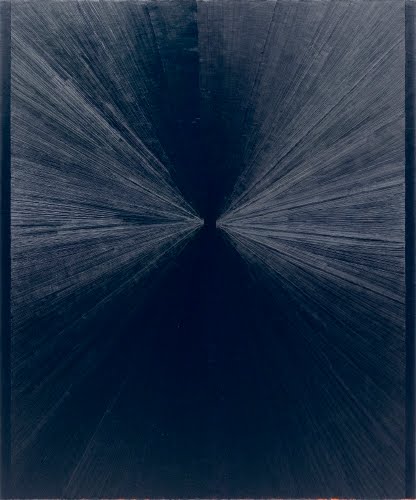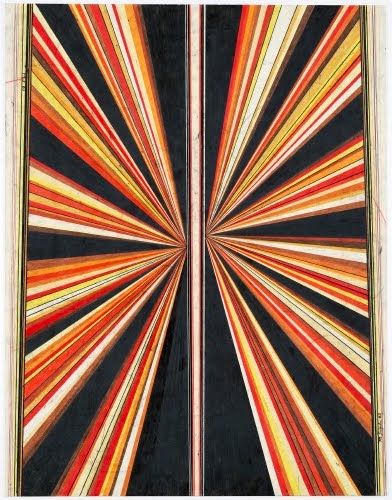Renaissance Perspective or Butterfly? Mark Grotjahn
I don’t like to admit to something like this, but when I first saw this work in the MoMA collection, I didn’t pay that much attention to it. When I saw it a second time the other day, I was like, “Wow!” Sometimes I wish everyone would try listening to a symphony by Johann Christian Bach (1735–1782) when they look at paintings the way I do at home when looking at my own work. The son of Johann Sebastian Bach (1685–1750), his music is so soothing.
 |
|---|
| Mark Grotjahn (born 1968, United States), Untitled (Painting Blue Light to Dark VII), 2006. Oil on canvas, 60" x 50" (152.4 x 127 cm). The Museum of Modern Art, New York. © 2017 Mark Grotjahn. (MOMA-P5043) |
It allows you to slow down and take in every aspect of a painting. I did that with this painting while listening to Pandora at work. It’s a visual pleasure overload!
There is something very visually seductive about this phase of Mark Grotjahn’s painting. It is so tempting to analyze his work in formal terms—Renaissance one-point perspective, Minimalism, Hard Edge painting (see the work below), blah blah. However, I think it’s a mistake to pin down one aspect of his work and blanket-categorize it. I prefer to look at it with the “untitled” hanging in my mind.
Although the precise one-point perspective draws in the eye, we’re immediately confronted with two rather than one vanishing points, slightly (ever-so-slightly in this work) askew. So, does that make Grotjahn’s “butterfly” works a stab at the rigidity of one-point perspective as taught to Renaissance painters? I prefer to think of Grotjahn searching for visual perfection. I much prefer these limited palette works (there’s a stunning one in black), where there is a surface tension aside from the lines of recession that borders on an Abstract Expressionist emphasis on process. And these works are most assuredly the result of a painstaking process.
Grotjahn, born in Pasadena, CA, received an MFA from UC Berkeley in 1995. Coming into his own in the theory-laden art scene of the 1990s, this artist chose to ignore the “art world’s” obsession with modernist analysis of the post-NeoExpressionist and post-Postmodern art scene. Early works included his “Sign Exchanges,” in which he painted replicas of homemade signs in mom-and-pop stores and exchange the painted for the original, which he hung in a gallery. This community-oriented project combined the similar aesthetics of Pop Art, Appropriation, and Dada readymades.
He began his “Perspective Series” (I don’t know if I like this designation any better than “butterfly”) in the early 2000s. The elements of these works were perspective, geometry, and color, which, I might add, he does brilliantly in some of these works, especially the ones done in color pencil. Right?! While the brilliantly executed lines of color inexorably create a compelling sense of depth, I’m not sure I would say that Grotjahn’s work reminds me of Op Art. Works like this one remind me of time-lapse color photographs of cars on an expressway.
 |
|---|
| Mark Grotjahn, Untitled (Butterfly), 2003. Colored pencil on paper, 38 ½" 30" (97.8 x 76.2 cm). The Museum of Modern Art, New York. © 2017 Mark Grotjahn. (MOMA-P1850) |
In 2007, he began in a new direction (I think of it as an Abstract Expressionist period, don’t hate me for using an art historical designation!) in which the perspective bands are sublimated to more gestural painting. Well, let me tell you, this had led to his exciting Mask works of the past five years, which are pretty darn interesting. Where’s the “butterfly”? you ask.
Interestingly, I read an interview with him recently in which he stated that he wants to return to total abstraction. This was in response to a question of whether the he considered the “mask” paintings “portraits.”


Comments